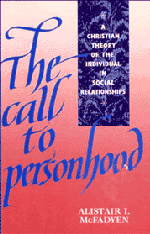Book contents
- Frontmatter
- Contents
- Acknowledgements
- Introduction
- Part I Persons in relation to God
- Part II Social relations
- Part III Interpersonal relations
- 4 The redemptive transformation of relations: dialogue
- 5 Personal integrity: centredness and orientation on others
- 6 Ethical resistance: testing the validity of disagreements
- Part IV Political relations
- Epilogue
- Notes
- Glossary
- Index
4 - The redemptive transformation of relations: dialogue
Published online by Cambridge University Press: 03 May 2011
- Frontmatter
- Contents
- Acknowledgements
- Introduction
- Part I Persons in relation to God
- Part II Social relations
- Part III Interpersonal relations
- 4 The redemptive transformation of relations: dialogue
- 5 Personal integrity: centredness and orientation on others
- 6 Ethical resistance: testing the validity of disagreements
- Part IV Political relations
- Epilogue
- Notes
- Glossary
- Index
Summary
So far I have been trying to show that personal identity is a structure of response sedimented from a significant history of communication. A person is centrally organised and, on that basis, may exercise a degree of autonomy as a subject of communication. Since this subjectivity and autonomy refer to communication, personal centredness does not only indicate the power to integrate one's internal life as a unity, but also denotes the power to enter communication and relation as such an internally unified being. Indeed, as a structure of communication, personhood is to be understood primarily in public terms. The centred way in which we organise ourselves as persons does not arise out of internal processes or out of any qualities or attributes which we hold individually; rather, it takes shape through our communication and relation with others. We cannot be personal centres in ourselves, left – as it were – to our own devices, since centredness is a learned and embedded practice of organising oneself in the public world of interacting with others. This way of centrally organising ourselves is sedimented from a significant history of relations in which the ways in which we are recognised and intended by others whirl around us and gradually become borne in on us. Following on from the position I took in the last chapter, it is my contention that this history will be a specific mediation of the pattern of personal co-intending, of social value and meaning, which is valid in our particular societies.
- Type
- Chapter
- Information
- The Call to PersonhoodA Christian Theory of the Individual in Social Relationships, pp. 113 - 150Publisher: Cambridge University PressPrint publication year: 1990

